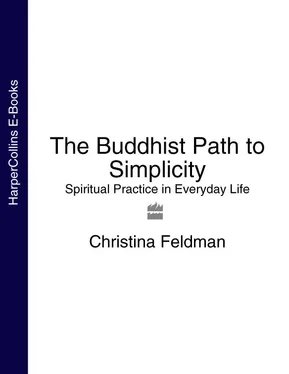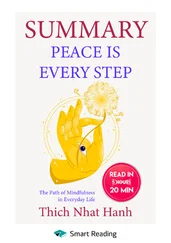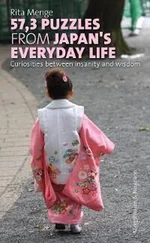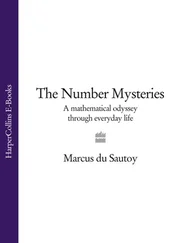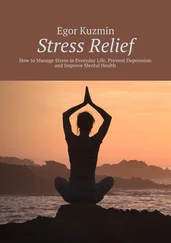The sticky, repetitive places our thoughts return to are messengers asking for our attention. What is being asked of us to release us from the complexity or confusion of this moment? Where does peace and calmness lie? Is there someone we need to forgive. Is there something we are being asked to let go of? Can we nurture a greater generosity of heart or compassion for ourselves or another? Ask yourself,
“Where does simplicity lie in this moment?”
Hold this question with a patient receptivity but without demanding an answer. Listen to the responses that arise within you. The release from complexity, the peace and calmness we seek for, will be found within those responses.
When my house burned down I gainedan unobstructed view of the moonlit sky ZEN
RENUNCIATION is the unwavering companion of simplicity. A life dedicated to depth and compassion invites us to let go of the layers of relentless need and thirst to accumulate that can govern our lives, and to understand the insecurities and anxieties that separate us from ourselves and others. Renunciation is the greatest of all kindnesses—it teaches us not to lean upon anything that can crumble; it teaches us about genuine richness and freedom.
Some years ago I went into a Thai monastery for a period of retreat. The first morning I took my seat in the meditation hall and waited for the teacher to arrive with instructions on how to meditate. I waited and waited. On the third day I summoned up the courage to ask the abbot, “What should I be doing when I sit on a cushion?” expecting to receive a complex formula of meditation instructions. He looked at me with a puzzled expression on his face before answering, “Sit down and let go.”
Can the heart of a meditative path be so simple—to sit down and let go? The lessons of simplicity teach us to love deeply and to let go; to savor each sound, taste, sight, and smell and to let go; to cherish each moment as a precious gift and to let go; to appreciate with profound sensitivity each connection with others, every thought and feeling, every birth and death, and to be a calm presence and conscious participant in their natural unfolding and passing. The path of simplicity is learning to live in harmony with the rhythms of life and each moment. It is a path of joy and freedom.
Hearing the word “renunciation” we may find our hearts quivering with fear and resistance. Images of ourselves as homeless and bereft, deprived of comfort and drowning in loneliness, pass through our minds. Renunciation may be equated with vulnerability and loss, a life of passivity and meaninglessness. We are faced with one of our deepest anxieties, of not knowing how we would define ourselves or find meaning without our array of possessions, opinions, beliefs, roles, and achievements. Culturally, we are encouraged to believe that possession, attainment, and achievement are the pathways to happiness. In the quest for simplicity we are invited to entertain another paradigm: that it is this very craving, holding, and possessiveness which brings complexity, confusion, and sorrow, and that renunciation is the mother of joy, simplicity, and freedom.
Complexity and entanglement have many sources in our lives. One of the main causes lies in the fear of losing what we have and the anxiety of not having enough. In fear of solitude and loneliness, we fill our lives and minds with distractions and busyness. Personal productivity has become the mantra of our time, the idea of stillness and simplicity terrifying—a sign of apathy or aimlessness. In the rush to be occupied endlessly and in the pursuit of stimulation, we neglect the quality of life, forget the simple joys of listening to the song of a bird, the laugh of a child, and the richness of one step taken with complete attention. George McDonald said:
Work is not always required of a person
There is such a thing as Sacred Idleness,
The cultivation of which is now
Fearfully neglected.
We may dream of a time when we can lie down beneath the night sky and do nothing but be present in its vastness with total attention. But our dreams are too often sabotaged by the busyness generated by anxiety. We seek evidence of our worth through what we produce, become, and surround ourselves with. Boredom has come to be regarded as one of our greatest enemies and we flee from it by generating endless complexity and busyness. Boredom may be no more than a surrender of sensitivity, yet, rather than turning our hearts and minds to rediscover that lost sensitivity, we thirst for even more exciting experiences, drama, and intensity. A young man about to bungee jump into the Grand Canyon was asked why he was engaging in such a perilous act. He answered, “These are the moments that shatter the boredom of living.” When alienated from inner vitality we mistake intensity for wakefulness.
In the search for calm simplicity it is important for us to remember our dreams of intimacy, stillness, and happiness; to value their discovery. We may need to remember that boredom is a state of mind and not an accurate description of reality. A meditation master listening to his student’s complaint of being bored, advised, “If you find something boring for ten minutes, stay with it for twenty minutes. If it’s still boring do it for an hour. Stay present until you know what it means to be alive.”
Some time ago the keepers at the Bronx Zoo became concerned when Gus the polar bear was observed swimming repetitively back and forth in his pool for hours on end. Animal psychologists and experts were consulted and the conclusion was that Gus was bored. Not that Gus wasn’t somewhat aggrieved at living in New York rather than bounding through snowdrifts, or may have missed his freedom; boredom was the problem that needed solving rather than the issue of Gus’s captivity. The solution—fill his pool with toys and distractions. As one keeper stated, “Hey, it works for us.”
The times when we feel most discontented are the times when our minds flee most readily to the past or future in search of guarantees, control, and safety. Inner complexity is easy to identify—the mind swirls with a burden of thoughts, images, anxiety, speculation, and obsession. The feeling of “I can’t let go” is a painful one. Seeking to end the pain of being trapped in our own turmoil, we make confused and desperate choices that lead to greater entanglement. Feeling adrift and fragmented, we search for happiness in the world of people, things, and fantasy, and find ourselves falling into familiar pits of frustration and discord.
The young Prince Siddhartha left the comfort and security of his palace and family to lead a homeless life, in search of enduring happiness and freedom. The homeless life is often praised as being the model of greatest renunciation. For many of us it is a much greater renunciation to discover what it really means to be at home in ourselves. To commit ourselves to being at home in our bodies, minds, hearts, and life, asks us to renounce the habit of abandoning ourselves and the moment. We often practice a kind of unconscious renunciation and homelessness—fleeing from where we are into the past or future and into the disconnected world of our daydreams and fantasies. To renounce the inclination to flee may be the greatest of all renunciations.
We find simplicity in our hearts and lives through paying attention to the roots of our complexity and then letting go. Albert Einstein advised, “Out of clutter, find simplicity. From discord, find harmony. In the middle of difficulty lies opportunity.” Simplicity does not rely on divorcing ourselves from the world or on adopting a path of austerity, but on a careful examination of our relationship to the acquisitions, opinions, objects, and dreams which crowd our lives. We bring a simple question into this maze of complexity: “What leads to happiness and what leads to complexity and confusion?”
Читать дальше
